INDESIT IWDE12 User Manual [fr]

Instructions for use
WASHER-DRYER
|
|
|
|
|
|
|
|
|
|
|
|
|
Contents |
|
|
|
|
|
|
|
GB |
||
|
|
|
|
|
|
|
|
|
|
|
|
|
Installation, 2-3-4-5 |
|
|
|
GB |
|
FR |
|
|
||
|
|
|
Unpacking and levelling |
||||
|
|
|
|
|
Electric and water connections |
||
|
|
|
|
|
|||
|
English,1 |
Français,15 |
The first wash cycle |
||||
|
|
|
|
|
Technical details |
||
|
|
|
|
|
Instructions for the fitter |
||
|
|
|
|
|
Washer-dryer description, 6-7 |
||
|
|
|
|
|
Control panel |
||
|
|
|
|
|
Leds |
||
|
|
|
|
|
Starting and Programmes, 8 |
||
|
|
|
|
|
Briefly: how to start a programme |
||
|
|
|
|
|
Programme table |
||
|
|
|
|
|
Personalisations, 9 |
||
|
|
|
|
|
Setting the temperature |
||
|
IWDE 12 |
|
|
Setting the drying cycle |
|||
|
|
|
|
|
Functions |
||
|
|
|
|
|
Detergents and laundry, 10 |
||
|
|
|
|
|
Detergent dispenser |
||
|
|
|
|
|
Preparing your laundry |
||
|
|
|
|
|
Special items |
||
|
|
|
|
|
Precautions and advice, 11 |
||
|
|
|
|
|
General safety |
||
|
|
|
|
|
Disposal |
||
|
|
|
|
|
Saving energy and respecting the environment |
||
|
|
|
|
|
Care and maintenance, 12 |
||
|
|
|
|
|
Cutting off the water or electricity supply |
||
|
|
|
|
|
Cleaning your appliance |
||
|
|
|
|
|
Cleaning the detergent dispenser |
||
|
|
|
|
|
Caring for your appliance door and drum |
||
|
|
|
|
|
Cleaning the pump |
||
|
|
|
|
|
Checking the water inlet hose |
||
|
|
|
|
|
Troubleshooting, 13 |
||
|
|
|
|
|
Service, 14 |
||
|
|
|
|
|
Before calling for Assistance |
||
1
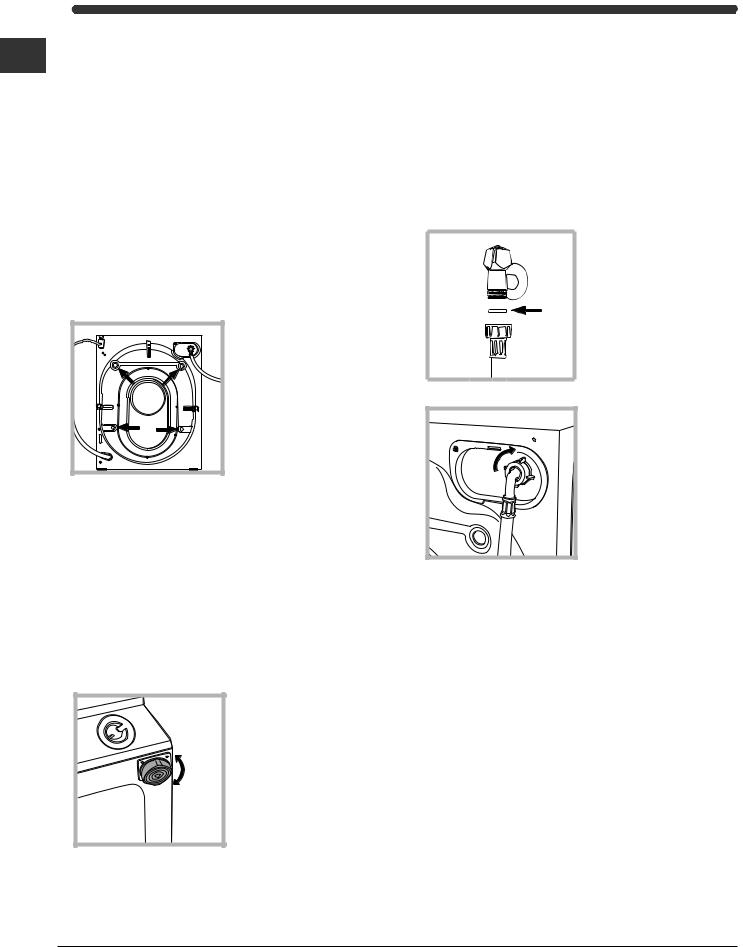
Installation
Keep this instruction manual in a safe place for GB future reference. Should the appliance be sold,
transferred or moved, make sure the instruction manual accompanies the Washer-dryer to inform the new owner as to its operation and features.
Read these instructions carefully: they contain vital information on installation, use and safety.
Unpacking and levelling
Unpacking
1.Unpack the Washer-dryer.
2.Check whether the Washer-dryer has been damaged during transport. If this is the case, do not install it and contact your retailer.
3. Remove the four protective screws and the rubber washer with the respective spacer, situated on the rear of the appliance (see figure).
4.Seal the gaps using the plastic plugs provided.
5.Keep all the parts: you will need them again if the Washer-dryer needs to be moved to another location.
Packaging materials are not children's toys.
Levelling
1. Install the Washer-dryer on a flat sturdy floor, without resting it up against walls, furniture cabinets or other.
2. If the floor is not perfectly level, compen-
sate for any unevenness by tightening or
loosening the adjustable
front feet (see figure); the angle of inclination, measured according to the worktop, must not
exceed 2°.
Levelling your appliance correctly will provide it with stability and avoid any vibrations, noise and shifting during operation. If it is placed on a fitted or loose carpet, adjust the feet in such a way as to allow enough room for ventilation beneath the Washerdryer.
Electric and water connections
Connecting the water inlet hose
1. Insert seal A into the end of the inlet hose and screw the latter onto a cold water tap with a 3/4 gas threaded
A |
mouth (see figure). |
|
|
|
Before making the |
|
connection, allow the |
|
water to run freely until |
|
it is perfectly clear. |
|
2. Connect the other end |
|
of the water inlet hose to |
|
the Washer-dryer, |
|
screwing it onto the |
|
appliance's cold water |
|
inlet, situated on the top |
|
right-hand side on the |
|
rear of the appliance |
|
(see figure). |
3. Make sure there are no kinks or bends in the hose.
The water pressure at the tap must be within the values indicated in the Technical details table
(on the next page).
If the water inlet hose is not long enough, contact a specialist store or an authorised serviceman.
Never use hoses that have already been used.
2

Connecting the drain hose
65 - 100 cm |
Connect the drain hose, without bending it, to a draining duct or a wall drain situated between 65 and 100 cm from the floor;
alternatively, place it over the edge of a basin, sink or tub, fastening the duct supplied to the tap (see figure). The free end of the hose should not be underwater.
We advise against the use of hose extensions; in case of absolute need, the extension must have the same diameter as the original hose and must not exceed 150 cm in length.
Electric connection
Before plugging the appliance into the mains socket, make sure that:
•the socket is earthed and in compliance with the applicable law;
•the socket is able to sustain the appliance's maximum power load indicated in the Technical details table (on the right);
•the supply voltage is included within the values i ndicated on the Technical details table
(on the right);
•the socket is compatible with the washing machine's plug. If this is not the case, replace the socket or the plug.
The washing machine should not be installed in an outdoor environment, not even when the area is sheltered, because it may be very dangerous to leave it exposed to rain and thunderstorms.
When the washing machine is installed, the mains socket must be within easy reach.
Do not use extensions or multiple sockets.
GB
The power supply cable must never be bent or dangerously compressed.
The power supply cable must only be replaced by an authorised serviceman.
Warning! The company denies all liability if and when these norms are not respected.
The first wash cycle
Once the appliance has been installed, and before you use it for the first time, run a wash cycle with detergent and no laundry, setting the 90°C programme without a pre-wash cycle.
Technical details
Model |
IWDE 12 |
||
|
|
||
|
59.5 cm wide |
||
Dimensions |
81.5 cm high |
||
|
54,5 cm deep |
||
|
|
||
Capacity |
from 1 to 6 kg for the wash programme; |
||
from 1 to 5 kg for the drying programme |
|||
|
|||
|
|
||
Electric |
please refer to the technical data plate |
||
connections |
fixed to the machine |
||
|
|
||
Water |
maximum pressure 1 MPa (10 bar) |
||
minimum pressure 0.05 MPa (0.5 bar) |
|||
connections |
|||
drum capacity 52 litres |
|||
|
|||
|
|
||
Spin speed |
up to 1200 rpm |
||
|
|
||
|
Wash: programme 2; temperature 60°C; |
||
Control |
run with a load of 6 kg. |
||
Drying: first drying cycle performed with |
|||
programmes |
|||
a 1 kg load, by selecting a drying time of |
|||
according to |
|||
60 min; |
|
||
EN 50229 |
|
||
Second drying cycle performed with a 5 |
|||
directive |
|||
kg load and the DRYING knob on |
|||
|
|||
|
the |
setting. |
|
This appliance is compliant with the following European Community Directives:
- 89/336/CEE of 03/05/89 (Electromagnetic Compatibility) and subsequent amendments
- 2002/96/CE
- 2006/95/CE (Low Voltage)
3
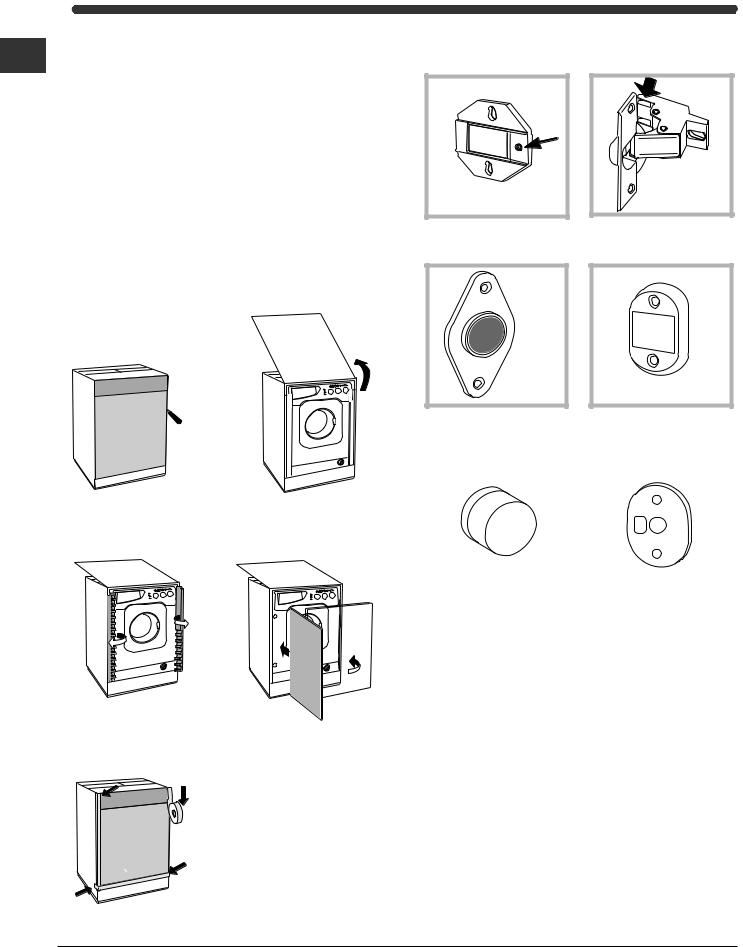
Instructions for the fitter |
Door Mounting Accessories (Fig. 1-2-3-4-5). |
||
GB |
|
|
|
Mounting the wooden panel onto the door and |
|
|
|
inserting the machine into cabinets: |
|
|
|
In the case where the machine must be shipped for final |
|
|
|
installation after the wooden panel has been mounted, we |
|
|
|
suggest leaving it in its original packaging. The packaging |
|
|
|
was designed to make it possible to mount the wooden |
|
|
|
panel onto the machine without removing it completely |
|
|
|
(see figures below). |
|
|
|
The wooden panel that covers the face of the machine |
N° 2 Hinge Supports |
N° 2 Hinges |
|
must not be less than 18 mm in thickness and can be |
Fig. 1 |
Fig. 2 |
|
hinged on either the right or left. For the sake of |
|||
|
|
||
practicality when using the machine, we recommend that |
|
|
|
the panel be hinged on the same side as the door for the |
|
|
|
machine itself - the left. |
|
|
|
N° 1 Magnet |
N° 1 Magnet plate |
Fig. 3 |
Fig. 4 |
A B
C D
Tur seite
E
|
N° 1 Rubber plug |
|
N° 4 Spacers |
|
|
|
|
|
|
|
|
Fig. 5 |
Fig. 4/B |
||
-No. 6 type A self-threading screws, l =13 mm.
-No. 2 type B metric, countersunk screws, l =25; for fastening the magnet plate to the cabinet.
-No. 4 type C metric screws, l =15 mm; for mounting the hinge supports to the cabinet.
-No. 4 type D metric screws, l =7 mm; for mounting the hinges on the supports.
Mounting the Parts onto the Face of the Machine.
-Fit the hinge supports to the appliance front panel, positioning the hole marked with an arrow in fig. 1 so that it is on the inner side of the front panel. Fit a spacer (fig. 4/B) between the surfaces using type C screws.
-Fit the magnet plate at the top of the opposite side, using type B screws to fix two spacers (fig. 4/B) between the plate and the surface.
4
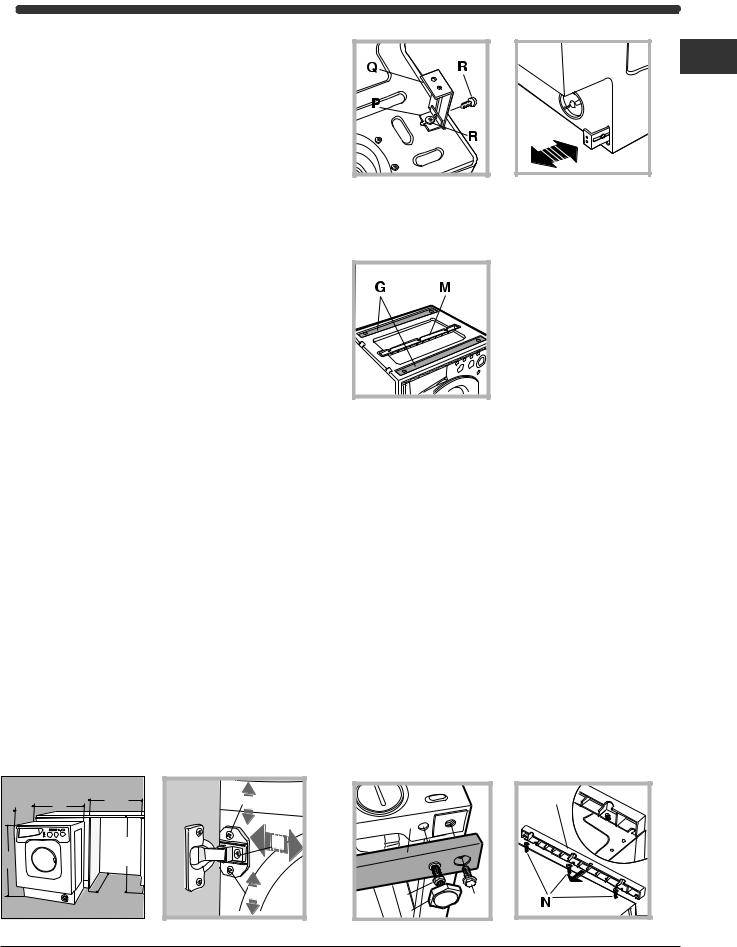
Using the Drilling Template.
-To trace the positions of the holes on the left-hand side of the panel, align the drilling template to the top left side of the panel using the lines traced on the extremities as a reference.
-To trace the positions of the holes on the right-hand side of the panel, align the drilling template to the top right side of the panel.
-Use an appropriately sized router to mill the holes for the two hinges, the rubber plug and the magnet.
Mounding the Parts onto the Wooden Panel (Door).
-Insert the hinges into the holes (the movable part of the hinge must be positioned facing away from the panel) and fasten them with the 4 type A screws.
-Insert the magnet into the top hole on the opposite side of the hinges and fasten it with the two type B screws.
-Insert the rubber plug into the bottom hole.
The panel is now ready to be mounted onto the machine.
Mounting the Panel into the machine.
Insert the nib of the hinge (indicated by the arrow in fig. 2) into the hole for the hinge and push the panel towards the front of the machine. Fasten the two hinges with the type D screws.
Fastening the plinth guide.
If the machine is installed at the end of a set of modular cabinets, mount either one or both of the guides for the base molding (as shown in fig. 8). Adjust them for depth based on the position of the base molding, and, if necessary, fasten the base to the guides (fig. 9).
This is how to assemble the plinth guide (fig. 8): Fasten angle P using screw R, insert plinth guide Q into
the special slot and once it is in the desired position, lock it in place using angle P and screw R.
Inserting the machine into the Cabinet.
-Push the machine into the opening, aligning it with the cabinets (fig. 6).
-Regulate the adjustable feet to raise the machine to the appropriate height.
-To adjust the position of the wooden panel in both the vertical and horizontal directions, use the C and D screws, as shown in fig. 7.
Important: close the lower part of the appliance front by ensuring that the plinth rests against the floor.
|
600 min |
|
540 |
595 |
|
|
|
|
815 |
|
900÷ 820 |
|
570 |
min |
Fig. 6
C |
D |
C |
Fig. 7
GB
Fig. 8 |
Fig. 9 |
Accessories provided for the height adjustment.
The following can be found inside the polystyrene lid (fig. 10): 2 crossbars (G), 1 strip (M)
the following can be found inside the appliance drum:
4additional feet (H),
4screws (I),
4 screws (R),
4 nuts (L),
2 plinth guides (Q)
Fig. 10
Adjusting the appliance height.
The height of the appliance can be adjusted (from 815 mm to 835 mm), by turning the 4 feet.
Should you require the appliance to be placed higher than the above height, you need to use the following accessories to raise it to up to 870 mm:
the two crossbars (G); the 4 feet (H); the 4 screws (I); the 4 nuts (L) then perform the following operations (fig. 11): remove the 4 original feet, place a crossbar G at the front of the appliance, fastening it in place using screws I (screwing them in where the original feet were) then insert the new feet H. Repeat the same operation at the back of the appliance. Now adjust feet H to raise or lower the appliance from 835 mm to 870 mm.
Once you have reached the desired height, lock nuts L onto crossbar G.
To adjust the appliance to a height between 870 mm and 900 mm, you need to mount strip M, adjusting feet H to the required height.
Insert the strip as follows:
loosen the three screws N situated at the front of the Top cover of the appliance, insert strip M as shown in fig. 12, then fasten screws N.
G |
|
|
L |
I |
|
H |
||
|
Fig. 11
M |
Fig. 12
5
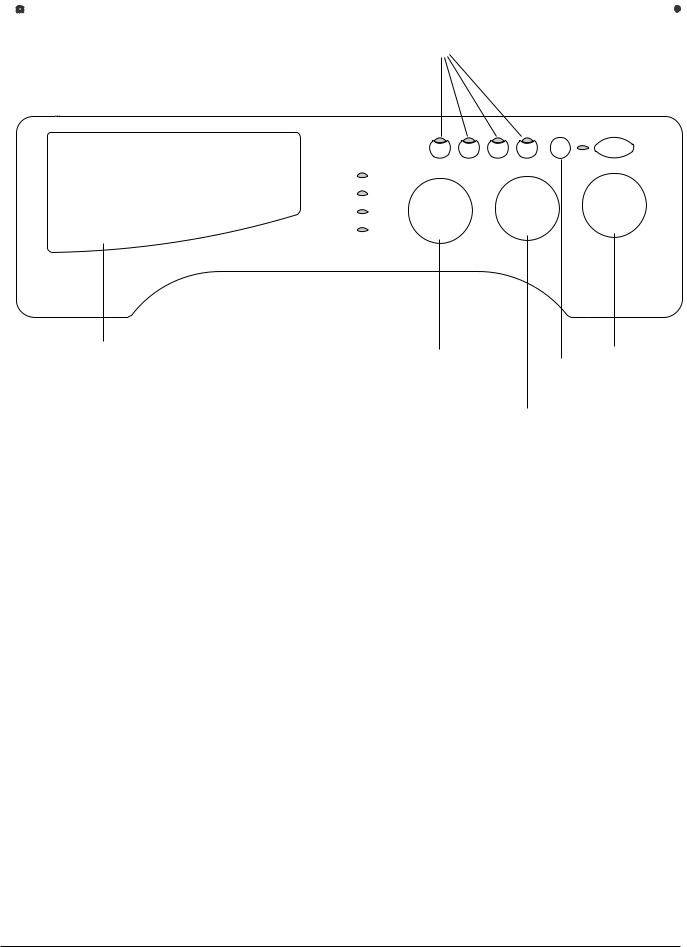
Washer-dryer description
|
|
|
|
|
|
|
|
|
Control panel |
|
FUNCTION |
ON-OFF/DOOR |
|||
|
|
Buttons |
|||||
GB |
|
|
|
LOCK Led |
|||
|
|
|
|
||||
|
|
Leds |
|
|
|
||
|
|
|
|
|
ON-OFF |
||
|
|
|
|
|
|
|
|
|
|
|
|
|
|
|
|
|
|
|
|
|
|
|
Button |
|
|
|
|
|
|
|
|
|
|
|
|
|
|
|
|
|
|
|
|
|
|
|
|
Detergent dispenser
DRYING |
START/RESET |
|
Knob |
||
Button |
||
|
||
|
TEMPERATURE |
|
|
Knob |
Detergent dispenser: to add detergent and fabric softener (see page 10).
LEDS: to find out which wash cycle phase is under way.
If the Delay Timer function has been set, the time left until the programme starts will be indicated (see page 7).
DRYING knob: to set the desired drying cycle
(see page 9).
FUNCTION buttons: to select the functions available. The button corresponding to the function selected will remain on.
TEMPERATURE knob: to set the temperature or the cold wash cycle (see page 9).
START/RESET button: to start the programmes or cancel any incorrect settings.
ON-OFF/DOOR LOCK Led: to find out whether the Washer-dryer is on and if the appliance door can be opened (see page 7).
ON/OFF button: to turn the Washer-dryer on and off.
PROGRAMME knob: to select the wash programmes. The knob stays still during the cycle.
Note: to avoid excessive vibrations, before every spin cycle the machine distributes the load in a uniform manner by continuously rotating the drum at a speed which is slightly faster than the normal washing speed.
When, despite repeated attempts, the load is still not evenly distributed, the machine spins at a lower speed than the set frequency.
If the load is excessively unbalanced, the machine attempts to distribute it instead of spinning.
The balancing attempts may extend the total duration of the cycle, up to a maximum of 10 minutes.
6
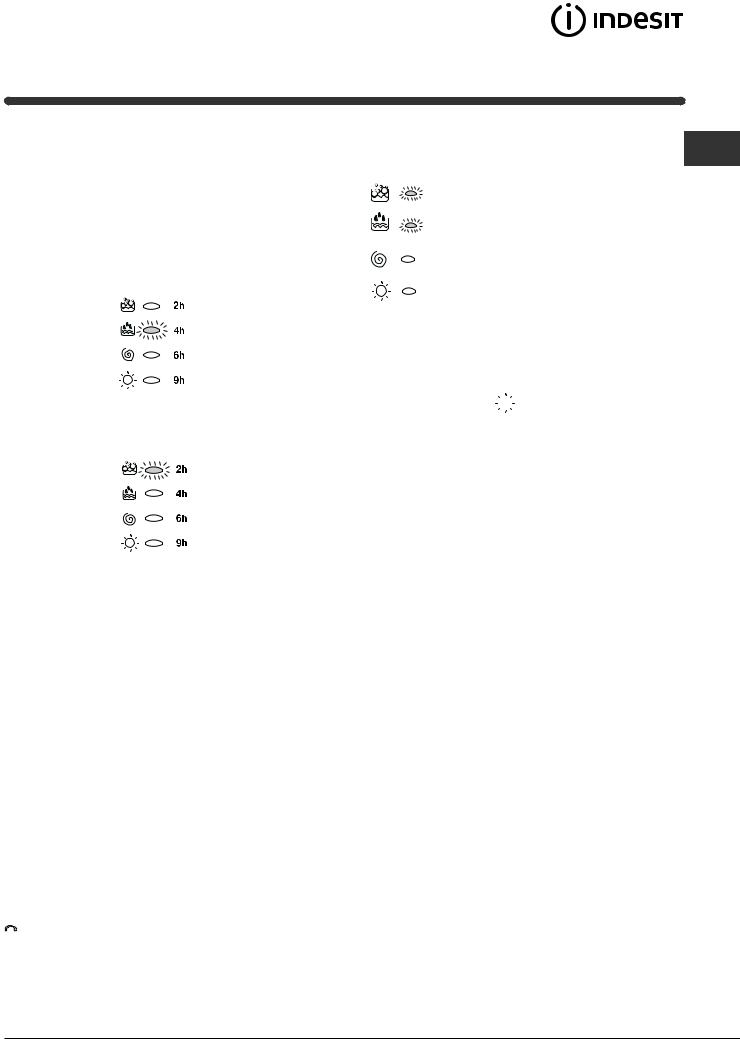
Leds
The LEDS provide important information. This is what they can tell you:
Delay set:
If the Delay Timer function has been enabled (see page. 9), once you have started the programme, the LED corresponding to the delay set will begin to flash:
As time passes, the remaining delay will be displayed, and the corresponding LED will flash:
Once the set delay is complete, the flashing LED will turn off and the programme set will start.
Cycle phase under way:
During the wash cycle, the LEDs gradually illumina- GB te on to indicate the cycle phase under way:
Prewash / Wash
Rinse
Spin cycle
Drying
Note:
-during draining, the LED corresponding to the Spin cycle phase will be turned on.
-when the drying cycle is complete, the indicator
light relative to phase  will flash, to indicate that the DRYING knob needs to be set back to the 0 setting.
will flash, to indicate that the DRYING knob needs to be set back to the 0 setting.
Function buttons
The FUNCTION BUTTONS also act like LEDS. When a function is selected, the corresponding button is illuminated.
If the function selected is incompatible with the programme set, the button will flash and the function will not be enabled.
If you set a function that is incompatible with another function you selected previously, only the last one selected will be enabled.
 ON-OFF/DOOR LOCK led
ON-OFF/DOOR LOCK led
If this LED is on, the appliance door is locked to prevent it from being opened accidentally; to avoid any damages, wait for the LED to flash before you open the appliance door.
The rapid flashing of the ON-OFF/DOOR LOCK Led together with the flashing of at least one other LED indicates there is an abnormality (see page 13).
7

Starting and Programmes
Briefly: starting a programme
GB |
1. Switch the Washer-dryer on by pressing button . |
|
|
|
All the LEDS will light up for a few seconds and |
|
the ON-OFF/DOOR LOCK Led will begin to flash. |
2.Load your laundry into the washing machine and shut the appliance door.
3.Set the PROGRAMME knob to the programme required.
4.Set the wash temperature (see page 9).
5.Set the drying cycle if necessary (see page 9).
Programme table
6.Add the detergent and any fabric softener (see page 10).
7.Start he programme by pressing the START/RESET button.
To cancel it, keep the START/RESET button pressed for at least 2 seconds.
8.When the programme is finished, the ON-OFF/ DOOR LOCK Led will flash to indicate that the appliance door can be opened. Take out your laundry and leave the appliance door ajar to allow
the drum to dry thoroughly. Turn the Washer-dryer off by pressing button  .
.
Type of fabric and |
|
Tempe- |
D rying |
D etergent |
Fabric |
Cycle |
|
||
Program. |
|
|
length |
D escription of wash cycle |
|||||
degree of soil |
|
rature |
C ycle |
pre- |
w ash |
softener |
(minutes) |
|
|
|
|
|
|
w ash |
|
|
|
||
|
|
|
|
|
|
|
|
||
Standard |
|
|
|
|
|
|
|
|
|
C otton: Extremely soiled whites |
1 |
90°C |
• |
• |
• |
• |
155 |
Pre-wash, wash cycle, rinse cycles, |
|
(sheets, tablecloths, etc.) |
intermediate and final spin cycles |
||||||||
|
|
|
|
|
|
|
|||
C otton: Extremely soiled whites |
2 |
90°C |
• |
- |
• |
• |
150 |
Wash cycle, rinse cycles, |
|
(sheets, tablecloths, etc.) |
intermediate and final spin cycles |
||||||||
|
|
|
|
|
|
|
|||
C otton: Heavily soiled whites and |
2 |
60°C |
• |
- |
• |
• |
140 |
Wash cycle, rinse cycles, |
|
fast colours |
intermediate and final spin cycles |
||||||||
|
|
|
|
|
|
|
|||
|
|
|
|
|
|
|
|
|
|
C otton: Heavily soiled whites and |
2 |
40°C |
• |
- |
• |
• |
125 |
Wash cycle, rinse cycles, |
|
delicate colours |
intermediate and final spin cycles |
||||||||
|
|
|
|
|
|
|
|||
Cotton: Slightly soiled whites and |
3 |
40°C |
• |
- |
• |
• |
85 |
Wash cycle, rinse cycles, |
|
delicate colours (shirts, jumpers, etc.) |
intermediate and final spin cycles |
||||||||
|
|
|
|
|
|
|
|||
|
|
|
|
|
|
|
|
|
|
Synthetics: Heavily soiled fast |
4 |
60°C |
• |
- |
• |
• |
83 |
Wash cycle, rinse cycles, anti-crease |
|
colours (baby linen, etc.) |
or delicate spin cycle |
||||||||
|
|
|
|
|
|
|
|||
Synthetics: Heavily soiled fast |
4 |
40°C |
• |
- |
• |
• |
70 |
Wash cycle, rinse cycles, anti-crease |
|
colours (baby linen, etc.) |
or delicate spin cycle |
||||||||
|
|
|
|
|
|
|
|||
W ool |
5 |
40°C |
- |
- |
• |
• |
50 |
Wash cycle, rinse cyclese, delicate |
|
spin cycle |
|||||||||
|
|
|
|
|
|
|
|
||
|
|
|
|
|
|
|
|
|
|
Very delicate fabrics |
6 |
30°C |
- |
- |
• |
• |
45 |
Wash cycle, rinse cycles, anti-crease |
|
(curtains, silk, viscose, etc.) |
or draining cycle |
||||||||
|
|
|
|
|
|
|
|||
Drying cotton |
7 |
- |
• |
- |
- |
- |
- |
|
|
|
|
|
|
|
|
|
|
|
|
Drying delicates |
8 |
- |
• |
- |
- |
- |
- |
|
|
|
|
|
|
|
|
|
|
|
|
Time 4 you |
|
|
|
|
|
|
|
|
|
C otton: Heavily soiled whites and |
9 |
60°C |
- |
- |
• |
• |
60 |
Wash cycle, rinse cycles, |
|
fast colours |
intermediate and final spin cycles |
||||||||
|
|
|
|
|
|
|
|||
Synthetics: Delicate colours |
10 |
40°C |
- |
- |
• |
• |
40 |
Wash cycle, rinse cycles, delicate |
|
(all types of slightly soiled garments) |
spin cycle |
||||||||
|
|
|
|
|
|
|
|||
Synthetics: Delicate colours |
11 |
30°C |
• |
- |
• |
• |
30 |
Wash cycle, rinse cycles and delicate |
|
(all types of slightly soiled garments) |
spin cycle |
||||||||
|
|
|
|
|
|
|
|||
Sport |
|
|
|
|
|
|
|
|
|
Sports shoes (MAX. 2 pairs) |
12 |
30°C |
- |
- |
• |
• |
50 |
Cold wash (without detergents), wash |
|
cycle, rinse cycles, and delicate spin cycle |
|||||||||
|
|
|
|
|
|
|
|
||
|
|
|
|
|
|
|
|
|
|
Fabrics for sportswear |
13 |
30°C |
- |
- |
• |
• |
60 |
Wash cycle, rinse cycles, |
|
(Tracksuits, shorts, etc.) |
intermediate and final spin cycles |
||||||||
|
|
|
|
|
|
|
|||
PARTIAL PROGRAMMES |
|
|
|
|
|
|
|
|
|
Rinse |
|
- |
• |
- |
- |
• |
- |
Rinse cycles and spin cycle |
|
|
|
|
|
|
|
|
|
|
|
Spin cycle |
|
- |
• |
- |
- |
- |
- |
Draining and spin cycle |
|
|
|
|
|
|
|
|
|
|
|
Drain |
|
- |
- |
- |
- |
- |
- |
Drain |
|
|
|
|
|
|
|
|
|
|
|
Notes
-For programme 9, we advise against exceeding a wash load of 3.5 kg. -For programme 13 we advise against exceeding a wash load of 2 kg.
-For the anti-crease function: see Easy iron, opposite page. The information contained in the table is purely indicative.
Special programme
Daily (programme 11 for Synthetics) is designed to wash lightly soiled garments in a short amount of time: it only lasts 30 minutes and allows you to save on both time and energy. By setting this programme (11 at 30°C), you can wash different fabrics together (except for woollen and silk items), with a maximum load of 3 kg.
We recommend the use of liquid detergent.
8
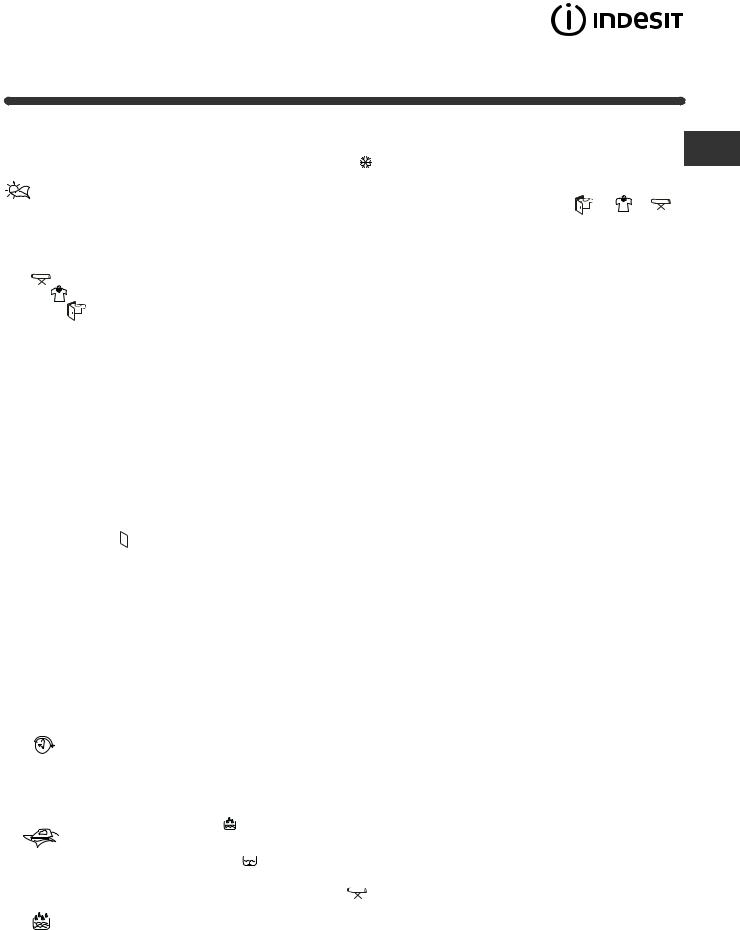
Personalisations
 C Setting the temperature
C Setting the temperature
Turn the TEMPERATURE knob to set the wash temperature (see Programme table on page 8). |
|
|
|
GB |
|||||
The temperature can be lowered, or even set to a cold wash ( |
). |
|
|
|
|
|
|||
|
|
The data contained in the |
|||||||
|
|
|
|
|
|
||||
|
Set the drying cycle |
Table of drying times |
|
table are purely indicative. |
|||||
|
|
|
|
|
|
|
|
||
|
Fabric |
Load type |
Max. |
|
|
|
|
||
Turn the DRYING knob to set the desired drying type. |
|
|
|
|
|||||
type |
|
load |
|
|
|
|
|||
Two options are available: |
|
|
(kg) |
Cup- |
Hanger |
Iron |
|
||
|
|
|
board |
|
|
|
|||
|
|
|
|
|
|
|
|
|
|
A - Based on time: From 40 minutes to 180. |
|
|
|
|
|
|
|
||
Cotton, |
Clothing of different sizes |
|
|
|
|
|
|||
B - Based on the damp level of the dry clothes: |
5 |
180 |
170 |
140 |
|
||||
Linen |
|
|
|||||||
|
|
|
|
|
|
|
|
|
|
Iron |
: slightly damp clothes, easy to iron. |
|
|
|
|
|
|
|
|
Hanger : dry clothes to put away. |
Cotton |
Terry towels |
5 |
180 |
170 |
140 |
|
||
Cupboard |
: very dry clothes, recommended for towelling |
|
|
|
|
|
|
|
|
Terital, |
Sheets, Shirts |
2,5 |
140 |
120 |
100 |
|
|||
and bathrobes. |
|
||||||||
Cotton |
|
|
|||||||
A cooling stage is foreseen at the end of the drying cycle. |
|
|
|
|
|
|
|
||
Acrylics |
Pyjamas, socks, etc. |
1 |
70 |
65 |
60 |
|
|||
|
|
|
|
||||||
If your laundry load to wash and dry is exceptionally in excess |
|
|
|
|
|
|
|
||
Nylon |
Slips, tights, stockings, etc. |
1 |
70 |
65 |
60 |
|
|||
of the maximum load foreseen (see table opposite), perform |
|
|
|
|
|
|
|
||
|
|
|
|
|
|
|
|||
the wash cycle, and when the programme is complete, divide up the garments and put part of them back in the drum. Now follow the instructions provided for a dry only cycle. Repeat this procedure for the remainder of the load.
Dry only
Turn the PROGRAMME knob to one of the drying settings (7-8) depending on the type of fabric, then select the desired drying type using the DRYING knob.
Important: - A spin cycle is carried out during the drying if you have set a cotton programme and a level of dryness (Cupboard  , Hanger
, Hanger  , Iron
, Iron  ).
).
- For cotton loads of less than 1 Kg, use the drying programme designed for delicate fabrics.
Functions
To enable a function:
1.press the button corresponding to the desired function, according to the table below;
2.the function is enabled when the corresponding button is illuminated.
Note: The rapid flashing of the button indicates that the corresponding function cannot be selected for the programme set.
Function |
Effect |
Comments |
|
Enabled with |
|
|
|
programmes: |
|
||||
|
|
|
|
|
|
|
|
|
|
|
|
||
|
|
Press the button repeatedly until the LED corresponding to the |
|
|
||
|
Delays the start |
desired delay is turned on. |
|
All |
|
|
|
of the wash by |
The fifth time the button is pressed, the function will be disabled. |
|
|||
|
up to 9 hours. |
N.B.: Once you have pressed the Start/Reset button, the delay |
|
|
||
Delay Timer |
|
can only be decreased if you wish to modify it. |
|
|
||
|
|
|
|
|
||
|
|
When this function is set, programmes 4, 6 will end with the |
|
|
||
|
This option |
laundry left to soak (Anti-crease) and the Rinse cycle phase |
|
|
||
|
reduces the |
LED |
will flash. |
|
3, 4, 6, |
|
|
amount of |
- to conclude the cycle, press the START/RESET button; |
|
|||
|
creasing on |
- to run the draining cycle alone, set the knob to the relative |
9, 10, |
|
||
|
fabrics, making |
symbol |
and press the START/RESET button. |
Rinse cycle. |
|
|
|
them easier to |
|
|
|
|
|
|
iron. |
If you also want to run the drying cycle, this button is enabled |
|
|
||
Easy iron |
|
only if combined with level |
(Iron). |
|
|
|
|
|
|
|
|
|
|
|
Increases the |
Recommended when the appliance has a full load or with large |
1, 2, 3, 4, 9, |
|
||
|
efficiency of the |
10, 12, 13, |
|
|||
|
quantities of detergent. |
|
|
|||
Extra Rinse |
rinse. |
|
Rinse cycle. |
|
||
|
|
|
|
|||
|
|
|
|
|
|
|
|
|
|
|
|
All |
|
|
Reduces the |
|
|
|
programmes |
|
|
|
|
|
except for 6, |
|
|
|
spin speed. |
|
|
|
|
|
|
|
|
|
7, 8 and |
|
|
|
|
|
|
|
|
|
1200-600 |
|
|
|
|
draining. |
|
|
|
|
|
|
|
|
|
|
|
|
|
|
|
9
